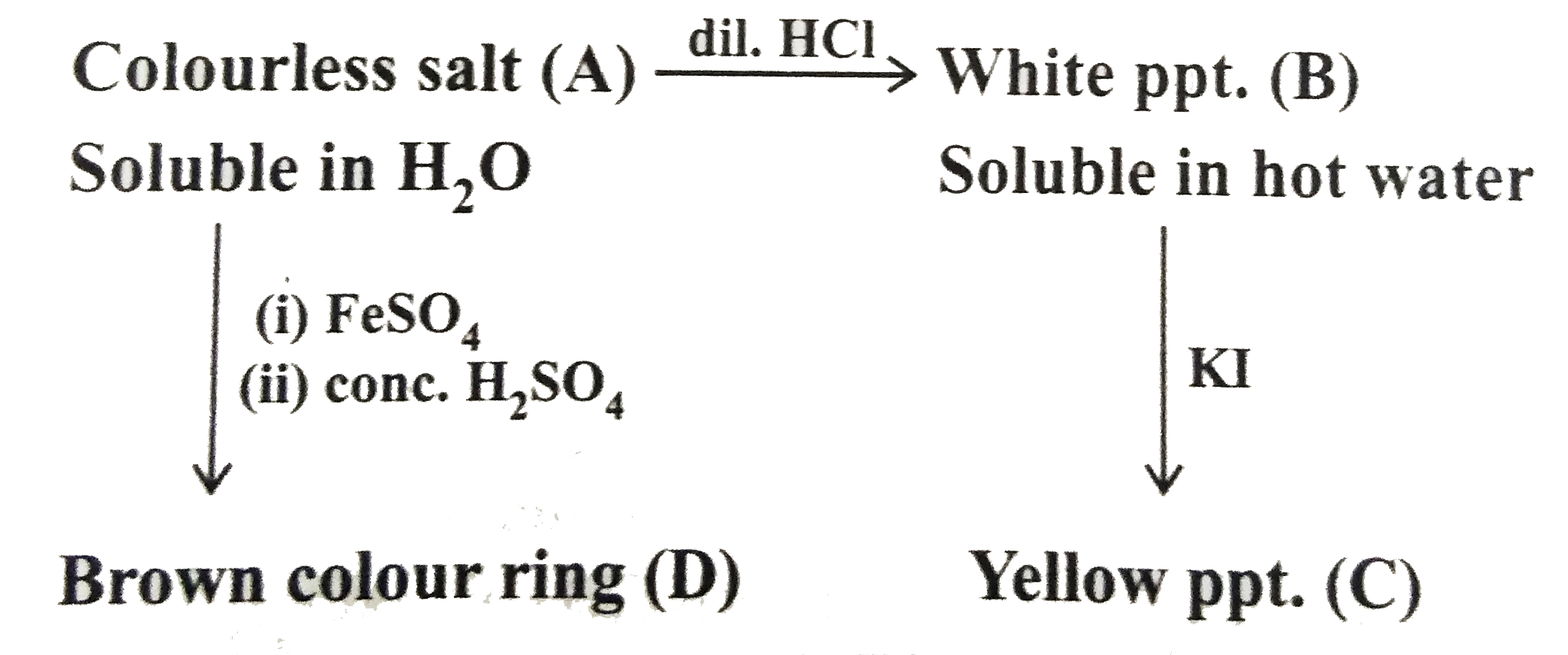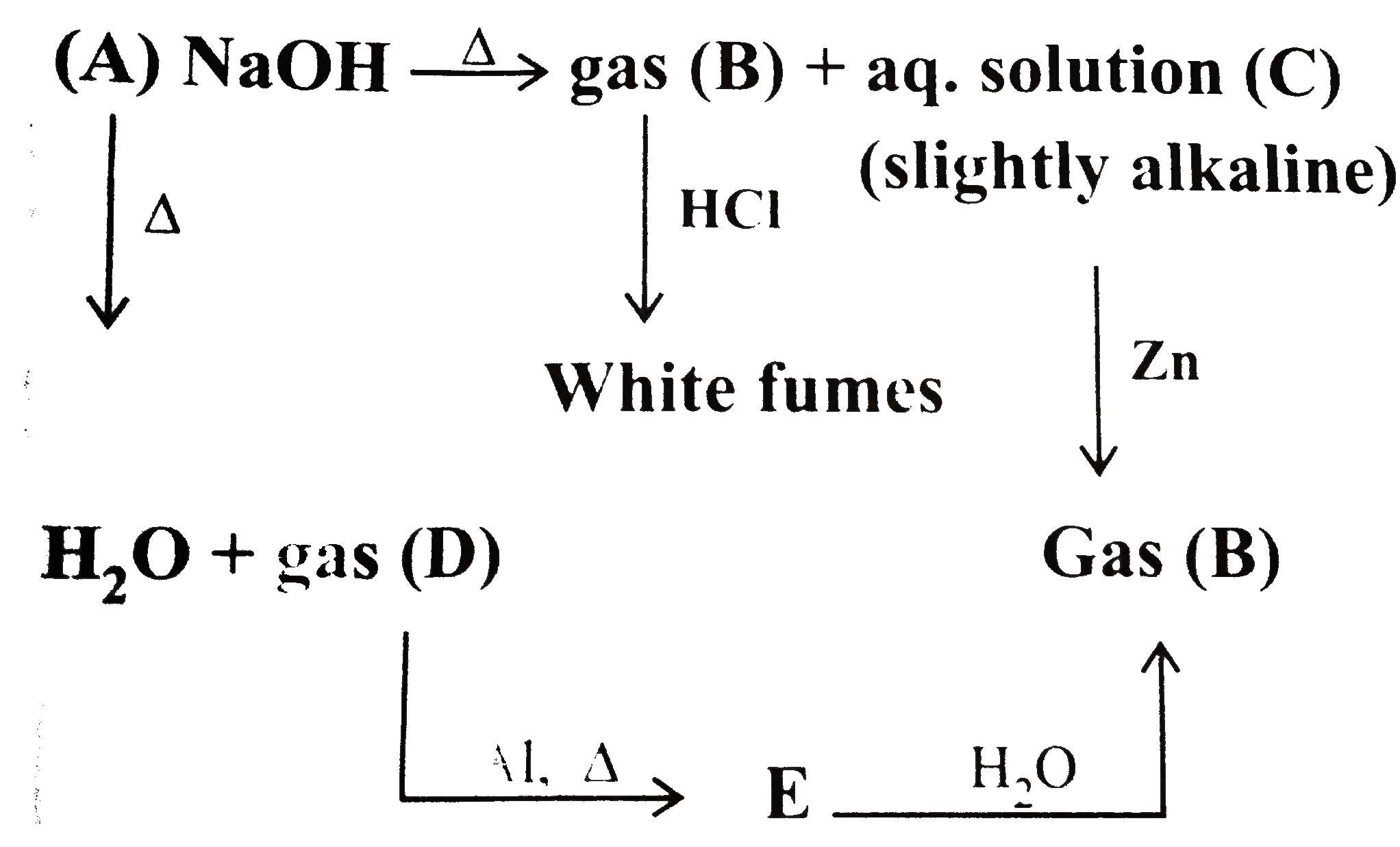Complete Solutions to Illiustration of chapter QUALITATIVE INORGANIC SALT ANALYSIS of Class 12 book with complete answers and questions
| Class 12 | CHEMISTRY |
| Chapter | QUALITATIVE INORGANIC SALT ANALYSIS |
| CENGAGE CHEMISTRY | Illiustration |
| Number Of Questions | 24 |
| Academic Year | 2023-24 |
a.`FeCI_(3)` is yellow in aqueous solution but no passing `H_(2)S` gas, solution rurns green Example.
b.Aqueous solution of `K_(2)Cr_(2)O`, (orange) changes to yellow .can you explain?
c. Potassium permanganate in purple in colour .On adding KOH, it turn gases, What is the compound formed?
d. A metailic statue under scis-rain attack turns to blushing -green colour .What can be the probable metal and salt formed ?
e. Oil painting turn blackish ater some time , What is the salt formed ? Assumeoil point contains `Pb^(2+)`View SolutionIdenity (A),(B) and (c )
`A + dii H_(2)SO_(4) rarr ` brown colour vapour turning (KI + statuck )paper blue
`A + NaOH overset(Delta)NH_(3)`gas
`(A) overset(Delta)rarr (B)`(gas) `+(C)` (gas, but liquid aty room temperature)
b. `CO_(2)` and `SO_(2)` both turn line water mily how will you detect the present if turn both are present in a mixture ?
c. `(A),(M_(2) X.7H_(2)O)` has water and `M_(2)X(M` is any divalent anion ) in `1.1` ratio by weight `K_(2)Cr_(2)PO_(3)H^(Theta) ` solution green idenlity (A) unit explain reaction
d. `(A)`,(Black) `+ dil. H_(2)SO_(4) rarr (B ) (gas) + (C )` (light green colour solution ). Gas (B) turns lead actate leat acetre paper black .What are (A) ,(B) and (C ) ?View Solutiona. Arrange `AgF, AgCI, AgBr` and `AgI` is the increasing order of solubility in water
b. `NO_(2)^(Theta)` interferes to the icing Test of `NO_(3)^(Theta) ` suggest a chemical method of removed burned with a blue flame initial but is put off uinstandly even as gas appear coming Example.
c. While testing oxalate, gas obtained burns with a blue flame intially but is put off instantly even as gas appears coming. Explain. d. `I^(Theta)` also interfere in the 'Ring Test' of `NO_(3)^(Theta)` suggest a chemical reagent that removed `I^(Theta)`
e. Colourless of `(A)overset(Delta) to ` (B) gas `+ (C )` gas aquens solution of (c ) turn rest litrman blue , aquerous solution of (A) and (B) also give while ppt , with `AgNO_(3)` solution souble in aqneous solution of (C ) identify (A) ,(B) and (C )
f. Can youy defect `Br^(Theta)` and `I^(Theta)` by layer if present together ?View Solutiona.(A) `+ KBr rarr ` yellow ppt . (B)
(A) `+ "conc". H_(2)SO_(4) overset(Delta) to` brown vapours intensifield with cu- turnings.
(B) dissolves in lypo forming a soluble complex (C ) what are (A),(B) and (C ) and explain their reactions ?
b. `SO_(3)^(2-)` and `SO_(4)^(2-)` both give while ppt with `BaCI_(2)` solution .How is `SO_(3)^(2-)` detected in presence of `SO_(4)^(2-)`?
c. `Na_(2)B_(4)O_(7).10 H_(2)O + "conc". H_(2)SO_(4) overset(Delta) to (A) overset(CH_(2)OH Delta) to (B)` idenity (A) and (B)
d. (A) `+ dii H_(2)SO_(4) overset(Delta) to gas (B)`
Gas (B) turns `K_(2)Cr_(2)O_(7) //H^(Theta)` solution green Aq solution of (A) `+ BaCI_(2) rarr ` while ppt .(C )
Filltrate after removing (C) `+ Br_(2)` water rarr while ppt` dissolve in qammon ium acetate solution Example.View SolutionColourless salt `(A) overset(dil. HCI)rarr` White ppt. (B)

Iidentify (A),(B),(C ) and (D)View SolutionIdentify (A),(B),(C ) and (D) in the following :
Colourless salt (A) `+ "conc" H_(2)SO_(4) rarr ` brawn fames intensifled on adding `Cu` turnings
Aqueous solution (A) `+ Cu rarr` blue colour solution (B) and metal (C )
Aquneous soluytion (A) `+ HCI rarr` white ppt soluble in equeous `NH_(3)` forming (D)View SolutionSalt (A) makes part of electrode and is insoluble in water (A) is blackened by `NH_(3)` forming (B),(B) is soluble is equa regia forming (C ),(C ) gives orange ppt with `KI` but ppt dissolves in extcess of `KI` forming (D ) , identify (A),(B),(C ) and (D)
View SolutionIf `Cu^(2+) and Cd^(2+)` both are present , it is difficult to outline a scheme to analyes in a mixture
View Solution`HgS` is soluble in aque regain forming `HgCI_(2)` What happens if Cu ruranings are added to `HgCI_(2)`?
View SolutionIdentify (A),(B),(C ),(D) and (E ), (A) (black) `+ dil HCI overset(Delta) to (B)` (solution) `+` (C ) (gas) ( C) turns lead aceetain paper black , (B) gives orange ppt (D ) solution in excess of `KI` forming (E ).
View SolutionSometimes it happens that when `H_(2)S ` gas is passed into solution in dii, `HCI` yellowish white turbility appears .What do you conclude ? What preperation are takes to check this turbidity?
View SolutionIIB (arsenic group ) sulphides are solution in `YAS` if cone `HCI` isadded to this soluble portion colour red ppt are formed Write reaction
View SolutionLight green solution of (A) does not give blue coloured ppt . With `K_(4)[Fe(CN)_(4)]` but on adding a drop of `HNO_(3)` blue ppt .(B) appears .However (A) gives blue colour (C ) with `K_(4)[Fe(CN)_(6)]` Example the formation of (B) and (C ) identify (A) if (A) also gives while ppt , with `AgNO_(3)` solution
View SolutionIdentify (A),(B),(C ) and (D) and example reactions .
(A) (green coloured salt) `+ K_(2)Cr_(2)O_(7) + "conc" H_(2)SO_(4) overset(Delta) to(B) `
(B) (redidish brown gas) + `NaOH rarr ( C) `
(C ) `+ (CH_(3)COO)_(2)Pb rarr (D ) `(yellow ppt)
`(A) +NaOH + Br_(2) water overset(Delta) to (C ) `
(C ) `+ (CH_(3)COO)_(2) Pb overset(Delta) to (D)`View Solutiona. (A) (yellow coloured solution ) changes to light green coloured solution (B) on passing `H_(2)S` gas (A) and (B) both give white ppt. with `BaCI_(2)` solution, insoluble in conc. `HCI`(A) given blue coloured ppt (C ) with `K_(4)[F2(CN)_(6)]` B does not .What are (A),(B) and (C )?
b. Identify A,B,C and D in the following reactions Bauxite + chemical `+ CI_(2) overset(Delta) to A + CO`
`A + H_(2)O rarr B + HCI, B + H_(2)SO_(4) rarr C + H_(2)O `
`B + NaOH rarr D + H_(2)O`View Solution(A) (colourless solution ) gives white ppt (B) with `NaOH` solution but ppt dissolves in excess of `NaOH` forming (C ) (C ) does not give ppt with `H_(2)S` but on boiling with `NH_(4)CI` while ppt (B) appears (A) also gives yellow ppt with `AgNO_(3)` identify (A),(B) and (C )
View SolutionTest tube (A)contains aqnous zine acetate solution while test tube (B) contains aq, zine chloride solution .What happens if `H_(2)S` gas is passed into each solution ?
View SolutionColourless solution of (A) gives while ppt (B) with `AgNO_(3)`soluble in aqueous `NH_(3)` (a) also while given ppt (C ) with `NaOH` soluble is extrable in excess of it forming (D),(D) gives ppt .(E) with `H_(2)S` identify (A),(B),(C ),(D) and (E ).
View Solution`MCI_(2) + K_(2)CrO_(4) rarr `yellow ppt what can be `MCI_(2)`
a. If it is soluble in hot water?
b. If is gives green colour in flame ?View Solution
(A)gives brick red colour in flame and decolourises `MnO_(4)^(Theta)//H^(o+)`, Gas (C ) burns with blue flame .identify (A),(B), (C ) and (D),View Solution`CaSO_(4)` in insoluble but is not preciplated when excess of `(NH_(4))_(2)SO_(4)` is added to `CaCI_(2)` explain
View Solution
Gas (D)`overset(HCI) to `while fumes
Gas(B)`overset(AI)underset(Delta)to (E ) overset(H_(2)O) to gas (B)`
Identify (A) to (H) and explain reactions.View SolutionIdentify (A),(B),(C ),(D) and (E ),
 View Solution
View SolutionColourless salt (A) gives apple- green flame with cone. `HCI` (A) on reaction with dil `H_(2)SO_(4)` give light brown flame (D) turning KI -strach paper blue.
(A) `+ CH_(3)COOH + K_(2)CrO_(4) rarr` yellow ppt (B)
(A) `+ H_(2)SO_(4) rarr (C ) ("white ppt") + (D)`
(D) `+ CH_(3)NH_(2) + CH_(3)OH + H_(2)O + gas (E )`
(E ) `+ Mg overset(Delta)to (F)`
(F) `+ H_(2)O rarr NH_(3)`
Identify (A) to (F) and explain reaction.View Solution
Illiustration questions and complete solutions for chapter QUALITATIVE INORGANIC SALT ANALYSIS of CENGAGE CHEMISTRY (HINGLISH) of Class 12
All Exercises from CENGAGE CHEMISTRY Class 12 CHEMISTRY QUALITATIVE INORGANIC SALT ANALYSIS
- Ex 8.1
- Ex 8.2
- Exercises (Assertion-Reasion)
- Exercises (Fill In The Blanks)
- Exercises (Integer) (Naming And Terminology
- Exercises (Linked Comprehension)
- Exercises (Multiple Correct) Part-A (Analysis Of Anions)
- Exercises (Multiple Correct) Part-B (Analysis Of Cations)
- Exercises (Multiple Correct) Part-C(Dry Test)
- Exercises (Multiple Correct) Part-D (Miscellaneous)
- Exercises (Single Correct) Part-A (Analysis Of Anions)
- Exercises (Single Correct) Part-B(Dry Test)
- Exercises (Single Correct) Part-C (Analysis Of Cations)
- Exercises (Single Correct) Part-D (Miscellaneous)
- Exercises (True And False )
- Exercises Archives (Assertion-Reasoning)
- Exercises Archives (Fill In The Blanks Ype)
- Exercises Archives (Integer)
- Exercises Archives (Linked Comprehension)
- Exercises Archives (Multiple Correct)
- Exercises Archives (Single Correct)
- Exercises Archives (Subjective)
- Exercises Archives (True/False)
- Illiustration
- Solved Example
- Viva Voce Questions And Part-A (Analysis Of Anions)
- Viva Voce Questions And Part-B (Dry Tests)
- Viva Voce Questions And Part-C (Analysis Of Cations)
